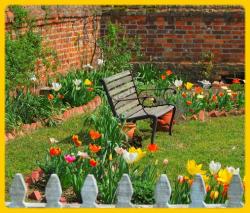|
| Garden Projects for Early Spring |
|
|
 The urge to garden in early spring is primal. Re-connecting with the earth is affirming, renewing, promising. Waking up the garden to a new growing season is about more than soil and seedlings...this rite of spring is a tonic to the gardener as well.
The urge to garden in early spring is primal. Re-connecting with the earth is affirming, renewing, promising. Waking up the garden to a new growing season is about more than soil and seedlings...this rite of spring is a tonic to the gardener as well.
∙ clear drainage ditches
Leaves and debris gather in drainage areas over the winter. Now is the time to ensure that the spring rains will have adequate runoff. Spring seedlings do best in soil which drains well. Because vegetative growth is at a low point in early spring, this is the easiest time of year for clearing drainage ditches. And be sure to put the cleared material, usually dead leaves and small branches, into the compost. Spring compost piles are commonly short on carbon-rich materials, and every addition helps.
∙ repair any bowed sides to raised beds. fix trellises and fencing.
Soggy winter soil puts a strain on raised beds; sometimes a stake will rot and give way. Any bowed or leaning sides should be fixed now. Dig back the soil behind the bowed side and drive in new stakes on the inside of the sideboards with a slight inward lean. Push sideboards up to stakes and fasten well with screws or nails
Trellises and fencing are also easiest to repair in early spring, with less growth to work around and fewer roots to disturb. Setting new fenceposts, however, is best done after the spring rains have had a chance to drain through the ground. If the water table is too high, post holes will fill with water as you try to dig.
∙ weed young spring weeds. mulch bare spots in beds.
Any weeds which appear in your garden beds will be easiest to pull now, as the roots are shallow. Covering bare spots with mulch or ground cover will minimize the emergence of new weeds. Adding mulch to a depth of 3 to 4 inches is usually sufficient. Black plastic sheeting can also be used to cover the beds before planting as a way to suppress emerging weeds. And if you flip the sheeting over once a week you may likely find slugs which have been hiding in the bed. This is a simple way to reduce the slug population in garden beds.
When adding mulch to garden beds or around the base of fruit trees, keep the mulch a few inches away from tree trunks and the crowns and stems of plants. This will help reduce rot on the stems of young plants and will protect the bark of young fruit trees.
Source:eartheasy.com |
| Monday, Mar 24, 2014 |
|
|
|
|
| » RENTALS |

|
|
|
| Commercial |
€ 500 |
|
| Location: |
Gorna Oryahovica |
|
|

|